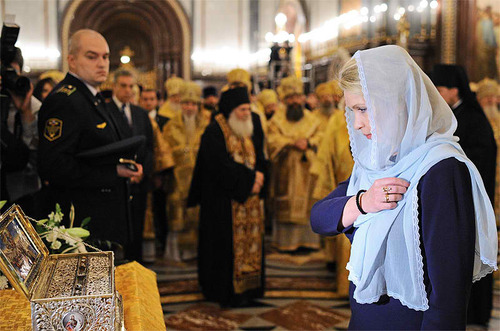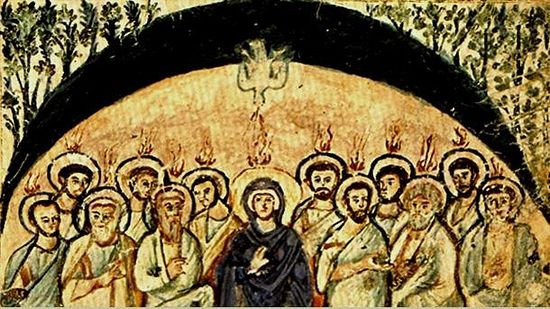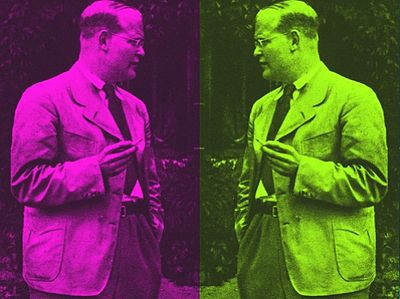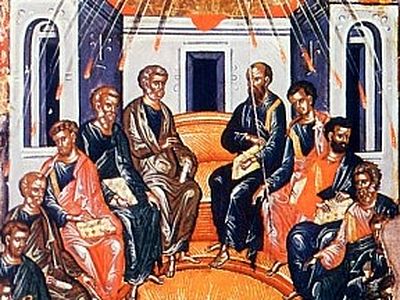“To Know God:” The Holy Spirit within us, Christ alive in the Church today, and living the sign of the Cross.
If ye love me, keep my commandments. And I will pray the Father, and he shall give you another Comforter, that he may abide with you forever; Even the Spirit of truth; whom the world cannot receive, because it seeth him not, neither knoweth him: but you know him; for he dwelleth with you, and shall be in you. I will not leave you orphans, I will come to you. Yet a little while, and the world seeth me no more; but you see me: because I live, you shall live also. In that day ye shall know, that I am in my Father, and ye in me, and I in you (John 14:15-20).
These beautiful words contain Jesus’ promise to His disciples that He would send them the Holy Spirit from the Father, “another Comforter” to abide with them—and with all the faithful—forever! The first verses are familiar to many as Elizabethan composer Thomas Tallis’ magnificent “If Ye Love Me” choral composition. I urge you to wonder at their meaning: Christ did not say that the Spirit would dwell “near” us or “by” us, but that he dwelleth with you, and shall be in you. It is by the grace of the Holy Spirit that in Christ we shall live also. Revealing the Trinity, Jesus tells us that by the Holy Spirit, ye shall know that I am in my Father ... and I in you.
What an extraordinary promise, that God in the third Person of the Holy Trinity will dwell with us and abide in us till the end of time!
Stirring testimonies left to us by so many of the saints bear witness to their profound awareness of Christ’s active presence in His Church on earth and the Spirit’s abiding presence in the hearts of the faithful. From St. Basil the Great, St. John Chrysostom, and many others among the early fathers, to St. Seraphim of Sarov, St. John of Kronstadt, and St. Silouan of the Holy Mountain, all the saints reaffirm that the Holy Spirit and Christ Himself are truly at work among us. One of the most beautiful passages about the Spirit left by St. Seraphim comes to mind when he describes the Holy Spirit as a fire,
warming and igniting the heart and inward parts. So, if we feel coldness in our hearts, which is from the devil (for the devil is cold), then let us call the Lord: He, in coming, will warm our heart with perfect love, not only towards Himself, but to our neighbors as well. And the coldness of the despiser of good will run from the face of His warmth.
From these words rings forth the centrality of the third Person of the Holy Trinity in Orthodox spirituality. Just as the Spirit is an active presence upon which the faithful are urged to call, Christ Himself is always present in the Church, which St. John of Kronstadt equates as
“one and the same with the Lord—His Body, of His flesh and His bones. The Church is the living vine, nourished by Him and growing in Him.”
When St. John wrote these words, he was reminding us that Christ is not only supporting the Church from heaven as His “living vine” on earth, but that Christ is truly alive in the Church, as much as His flesh and bones are of Him! By the grace of the Holy Spirit, the Church continues to grow in Him here on earth.
St. John continues by urging us to think of the Church not as a man-made institution or earthly thing, for in truth it is neither, but to think of it together with “the Lord Jesus Christ, the Father and Holy Spirit.”
While the Church on earth is partially in the care of wise yet fallible men, it is above all in the loving care of Christ, its Creator and eternal Head. The late Bishop Basil (Rodzianko) of blessed memory spent the closing years of his life at St. Nicholas Cathedral in Washington. Fr. Valery Shemchuk once told me that His Grace often said that God made creation itself so that there might someday be a Church. In saying this, Bishop Basil was underlining not only the timeless and divinely preordained mission of the Church, but that the very purpose of man’s existence is to draw closer to God in the life of the Church.
Similarly, Bishop Kallistos observes that “Orthodox theology never treats the earthly aspect of the Church in isolation, but thinks always of the Church in Christ and the Holy Spirit. All Orthodox thinking about the Church starts with the special relationship which exists between the Church and God.” By this “special relationship,” through participation in the inner life of the Church by the grace of the Holy Spirit, we may come not only to believe in God, but even to know Him. As St. Silouan observes, “Enlightened by baptism, people believe in God. But there are some who even know Him. To believe in God is good, but it is more blessed to know God.”
How does the venerable elder describe those who “have come to know God by the Holy Spirit?” They “stretch upward day and night, insatiable, to the living God, for the love of God is very sweet.” May we all aspire to this intimate knowledge of the love of God in our souls, “stretching upward” to touch the very heavens.

One of the most profoundly simple ways to invite God into our hearts is to make the sign of the Cross over ourselves. You will notice when you enter an Orthodox church that people make the sign of the Cross quite frequently, often accompanied by a bow. Worshipers cross themselves during the Liturgy whenever the doxology is invoked, which is quite often in comparison to Western Christian services, they cross themselves when praying before icons, and they cross themselves in their own private devotions, in morning and evening worship. There is a particular symbolic beauty to the Orthodox method, in terms of how it is done physically, which you should find out for yourself. I have seen many old men and women at church perform the most beautiful crossings upon themselves, with faith shining in their eyes, and I have witnessed the loving kindness with which my archbishop, His Beatitude Metropolitan Jonah, greets individual members of the congregation after the Divine Liturgy, holding out the gold cross for people to kiss. If you catch him later for a blessing, he makes the sign with his right hand over your cupped hands in the same ancient way Our Savior holds His own right hand in benediction in every icon.
Certainly, the sign of the Cross is very important, for it is the physical symbol of the Christian faith. Yet it occurred to me recently that the perfect sign of the Cross is not actually a precisely-done hand gesture or movement at all. As Christians, the sign is something much more meaningful than a physical motion with our right hand. We are called to make the sign of the Cross each day within our hearts, as a quiet commitment in all that we do, asking that the Holy Spirit illumine every aspect of our lives. Truly, by living in imitation of Christ’s loving example, we live the sign, we live the Cross. This is by no means easy—indeed it is a great challenge—but it is the most beautiful, the most fulfilling one ever offered to mankind.
Just as we are challenged to live the sign as much as we find comfort in performing it over ourselves, implicit in the very word “Orthodox” is not only an obligation to observe the many traditions of the Church that constitute “right belief,” but to live in a spirit of “right glory” toward one’s fellow man made in the image of God. Thus, Orthodoxy in its truest form is a resounding call to work toward holistic social justice which embraces and strives to heal and foster the whole of the human person—body, mind, soul and spirit. It is a call to live in philanthropia, that is, a profound love for mankind.
As Bishop Kallistos reminds us from the words of 1 John 4:20,
Love of God and love of neighbor are inseparable. A person can love his neighbor as himself only if he loves God above all; and a person cannot love God if he does not love his fellow humans ... only if he loves his fellow neighbor can a person be deified.
Thus, outside of philanthropia, there is no possible way we can become like unto God through divinization. Because humans are “made in the image of the divine Trinity,” we can only realize “the divine likeness” if we “live a common life such as the Blessed Trinity lives: as the three persons of the Godhead ‘dwell’ in one another, so we must ‘dwell’ in our fellow humans, living not for ourselves alone, but in and for others ... Such is the true nature of theosis.”
As St. Silouan observes, “Blessed is the soul that loves her brother, for our brother is our life. The Spirit of the Lord lives manifest within her, giving peace and gladness.”
It is this inner peace which comes from exercising the Church’s calling to the highest form of love: agape, or love of the image of God in every person.




